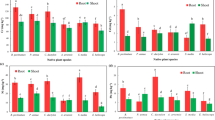Abstract
Effect of various concentrations of humic acid (0.2 to 1%) on thebioavailability of γ-HCH in vegetative clones of theaquatic fern Marsilea minuta was studied in a staticexperimental bioassay system on different photoperiods. Additionof humic acid showed the reduction in the bioavailability ofγ-HCH in all the photoperiods (72 hr light to 144 hrlight) at the interval of 16 hr light (L) and 8 hr dark (D) inboth aerial and submerged portion as compared to controlindicating its protective role in toxicity.
Similar content being viewed by others
References
Biernacki, M., Lovett-Doust, J. and Lovett-Doust, L.: 1997, ‘Laboratory assay of sediment phytotoxicity using the macrophyte Vallisneria american’, Environ. Toxicol. Chem. 16, 472–478.
Brix, H. and Schierup, H. H.: 1989, ‘The aquatic macrophytes in water pollution control’, Ambio 18, 100–107.
Bruggeman, W. A.: 1982, ‘Hydrophobic interactions in aquatic environment’, in: O. Hutzinger (ed.), Handbook of Environmental Chemistry, Vol. 2, Part B, Springer-Verlag, Berlin pp. 83–102.
Canonica, S., Jans, U., Stemmler, K. and Hoigne, J.: 1995, ‘Transformation kinetics of phenols in water. Photosensitization by dissolved natural organic material and aromatic ketons’, Environ. Sci. Technol. 29, 1822–1831.
Charpentier, S., Garnier, J. and Flaugnatti, R.: 1987, ‘Toxicity and bioaccumulation of cadmium in experimental cultures of Suckweed, L. polyrrhiza (L)’, Bull. Environ. Contam. Toxicol. 38, 1055–1061.
Chiou, C. T., Kile, D. E., Brinton, T. L., Malcolm, R. L., Leenheer, J. A. and MacCarthy, P.: 1987, ‘A comparison of water solubility enhancements of organic solutes by aqueous humic materials and commercial humic acids’, Environ. Sci. Technol. 21, 1231–1234.
Cooper, W-J., Zika, R. G., Petasne, R. G. and Fischer, A. M.: 1989, ‘Sunlight induced photochemistry of humic substances in natural waters: Major reactive species. In Aquatic humic substances: Influence of fate of treatment of Pollutants'. Advances in Chemistry Series 219 (I. H. Suffet and P. MacCarthy, eds.), pp. 332–362. Am Chem Soc Washington, D.C.
Cunningham, S. D., Anderson, T., Schwab, P. and Hsu, F.: 1996, ‘Phytoremediation of soil contaminated with organic pollutants'. Adv. Agron. 56, 55–114.
Day, K.: 1991, ‘Effect of dissolved organic carbon on accumulation and acute toxicity of fenvalerate, deltamethrin and cyhalothrin to Daphnia magna (Strauss)’, Environ. Toxicol. Chem. 10, 91–101.
EPA (Environmental Protection Agency): 1975, ‘Test methods for assessing the effect of chemicals in plants’, EPA 560–17–75–008, Final report, US Environmental Agency, Washington, DC.
Goodrich, M. S., Dulak, L. H., Friedmen, M. A. and Lech, J. J.: 1991, ‘Acute and long term toxicity of water soluble cationic polymers to rainbow trout (Oncorhynchus mykiss) and the modification of toxicity by humic acid’, Environ. Toxicol. Chem. 10, 509–515.
Guilizzoni, P.: 1991, ‘The role of heavy metals and toxic materials in the physiological ecology of submerged macrophytes’, Aquatic Botany 41, 87–109.
Jaffe, R.: 1991, ‘Fate of hydrophobic organic pollutants in the aquatic environment, A review’, Environ. Pollut. 69, 237–257.
Landrum, P. F., Reinhold, M. D., Nihart, S. R. and Eadie, B. J.: 1985, ‘Predicting the bioavailability of organic xenobiotics to Pontoporeia hoyi in the presence of humic and fulvic materials and natural dissolved organic matter’, Environ. Toxicol. Chem. 4, 459–467.
Lores, E. M., Patrick, J. M. and Summers, J. K.: 1993, ‘Humic acid effects on uptake of hexachlorobiphenyl by sheepshead minnows on static sediment/water systems’, Environ. Toxicol. Chem. 12, 541–550.
Lovett-Doust, L., Lovett-Doust, J. and Biernacki, M.: 1994a, ‘American Wildcelery, Vallisneria americana, as a biomonitor of organic contaminants in aquatic ecosystems’, J. Great Lakes Res. 20, 333–354.
Lovett-Doust, J., Schmidt, M. and Lovett-Doust, L.: 1994b, ‘Biological assessment of aquatic pollution: A review, with emphasis on plants as biomonitors’, Biol. Rev. 69, 147–186.
Manny, B. A. and Kenaga, D.: 1991, ‘The Detroit River: Effects of contaminants and human activities on aquatic plants and animals and their habitats’, Hydrobiologia 219, 269–279.
Means, J. C. and Wijayratne, R. D.: 1982, ‘Role of natural colloids in the transport of hydrophobic pollutants’, Science 215, 968–970.
Misra, V., Pandey, S. D. and Viswanathan, P. N.: 1996a, ‘Binding of γ-hexachloro-cyclohexane with humic acid and chlorophyll in aquatic environment in relation to ecotoxicity’, Int. J. Environ. Anal. Chem. 64, 257–264.
Misra, V., Pandey, S. D. and Viswanathan, P. N.: 1996b, ‘Environmental significance of humic acid in the sequestration of metals’, Chemistry and Ecology 13, 103–112.
Misra, V., Pandey, S. D. and Viswanthan, P. N.: 1998, ‘Chemical approach to study the environmental implications of humic acid and γ-HCH interaction’, Chemistry and Ecology 14, 97–106.
Muir, D. C. G., Hobden, B. R. and Servos, M. R.: 1994, ‘Bioconcentration of pyrethroid insecticides and DDT by rainbouw trout: uptake, depuration, and effect of dissolved organic carbon’, Aquat Toxicol 29, 223–240.
Ortego, L. S. and Benson, W. H.: 1992, ‘Effects of dissolved humic materials on the toxicity of selected pyrethroid insecticides’, Environ Toxicol Chem 11, 261–265.
Rav-Acha, C. H. and Rebhun, M.: 1992, ‘Binding of organic solutes to dissolved humic substances and its effect on adsorption and transport in the aquatic environment’, Water Res. 26, 1645–1654
Salomons, W., de Rooij, N. M., Kerdigk, H. and Bril, J.: 1987, ‘Sediments as a source for contaminants’, Hydrobiol. 149, 13–30.
Salt, D., Blaylock, M., Kumar, N., Dushenkov, V., Ensley, B., Chet, I. and Raskin, I.: 1995, ‘Phytoremediation. A novel strategy for the removal of toxic metals from the environment using plants’, Biotechnology 13, 468–474.
Singh, J., Devi, S., Chawla, G., Gupta, M. and Viswanathan, P. N.: 1991, ‘Ultrastructural and biochemical effects of cadmium on the aquatic fern Marsilea minuta (L)’, Ecotoxicol Environ Saf. 21, 171–18.
Tan, K. H.: 1994, Environmental Soil Science, Marcel Dekker, Inc. N. York.
Vrana, D. and Votruba, J.: 1995, ‘Influence of soluble humic substances of the growth of algae and blue green algae’, Folia Microbiol. 40, 207–208.
Author information
Authors and Affiliations
Rights and permissions
About this article
Cite this article
Misra, V., Pandey, S.D. & Viswanathan, P.N. Effect of Humic Acid on the Bioavailability of γ-Hexachlorocyclohexane in Marsilea Minuta (L.). Environ Monit Assess 61, 231–237 (2000). https://doi.org/10.1023/A:1006171206492
Issue Date:
DOI: https://doi.org/10.1023/A:1006171206492




